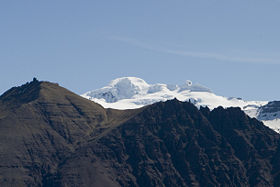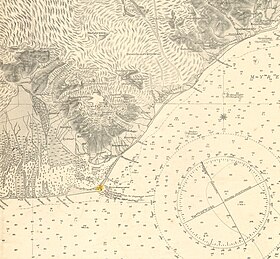| Öræfajökull | |
|---|---|
 | |
| Highest point | |
| Elevation | 2,109.6 metres (6,921 ft) at Hvannadalshnúkur |
| Prominence | 2,109.6 metres (6,921 ft) at Hvannadalshnúkur |
| Coordinates | 64°00′N 16°39′W / 64.000°N 16.650°W / 64.000; -16.650 |
| Dimensions | |
| Area | 400 km (150 sq mi) |
| Volume | 300 km (72 cu mi) |
| Geography | |
| Location | Iceland |
| Geology | |
| Rock age | Pleistocene |
| Mountain type | Stratovolcano |
| Last eruption | 3 August 1727 to May 1728 |
| Topographic features of Öræfajökull. The approximate outline of the central volcano is outlined in red with caldera features in red shading. White/blue shading show glacier features relevant to jökulhlaup risk. The peak Hvannadalshnúkur has a marker. More detail or zoom out to show other volcanoes in the Öræfi volcanic belt (brown shading) is available on clicking the image to enable mouse-over. | |

Öræfajökull (Icelandic pronunciation: [ˈœːrˌaiːvaˌjœːkʏtl̥] ; 'Öræfi glacier' or 'wasteland glacier') is an ice-covered volcano in south-east Iceland. The largest active volcano and the highest peak in Iceland at 2,110 metres (6,920 ft), it lies within the Vatnajökull National Park and is covered by part of the glacier.
The original Norse settlers named the volcano Knappafellsjǫkull (Old Norse: [ˈknɑpːɑˌfelːsˌjɔkolː]; Modern Icelandic: Hnappafellsjökull [ˈn̥ahpaˌfɛlsˌjœːkʏtl̥]; 'knobs mountain glacier'). The current name, Öræfajökull, was eventually adopted after the 1362 eruption.
Description
Öræfajökull is located at the southern extremity of the Vatnajökull glacier and overlooking the Ring Road between Höfn and Vík. It is the largest active volcano in the country, and on the summit crater's north-western rim is Hvannadalshnúkur, the highest peak in Iceland at 2,110 metres (6,920 ft).
Geographically, Öræfajökull as the glacier, is considered part of Vatnajökull, and the area covered by glacier is within the boundary of Vatnajökull National Park. There are a number of outlet glaciers in the ice cap within the area of the central volcano which clockwise from north are: Breiðamerkurjökull, Fjallsjökull, Hrútárjökull, Bræðrajökull, Kviarjökull, Hólárjökull, Stórhöfðajökull, Gljúfursárjökull, Rótarfjallsjökull (which has a western branch called Kotárjökull), Grænafjallsjökull, Falljökull, Virkisjökull, Svinafellsjökull and Skaftafellsjökull. While most of the outlet glaciers have reasonably clear catchments, not all do. Some of the icecap feeds directly into river catchments without a named glacier and this happens between the Hrútárjökull and Bræðrajökull, and the Virkisá river drains a number of glaciers between Rótarfjallsjökull and Svinafellsjökull (see map on this page).
The summit caldera of this stratovolcano is 3 km × 4 km (1.9 mi × 2.5 mi) and the volcano is 20 km (12 mi) in diameter. It is the most southern of the volcanoes in the Öræfi volcanic belt (Öræfajökull volcanic belt), which is possibly an embryonic rift parallel and to the east of the Eastern volcanic zone. The presently active summit caldera may have a subcaldera within it. Eruptions in this area are most likely to result in jökulhlaups that will produce floods at the outlets of the Kviarjökull and Virkisá catchments as these overlap the present caldera. There is possibly an old caldera to the north of the current caldera and flank eruptions could produce jökulhlaup from other outlet glaciers. The topographical map on this page can be enlarged to show this detail.
Activity
Öræfajökull has erupted twice in historical times, in 1362 and 1728. These were explosive silicic eruptions with bulk tephra volumes of 0.1–10.0 km (0.024–2.399 cu mi) and jökulhlaups occurred. The deposits closer to the central volcano are rhyolytic but the more distal lava flows which can extend for 20 km (12 mi) from the caldera are alkali olivine basalt and both have been erupted in the Holocene.
1362 eruption
In 1362, Knappafellsjökull erupted explosively, ejecting 10 cubic kilometres of tephra, similar in scale to the 1991 eruption of Mount Pinatubo. The eruption sequence lasted for several months, being from a medium-potassium alkali rhyolite and has been assigned a VEI of 6 although dense-rock equivalent volume may be less than previous estimates at 1.2 km (0.29 cu mi). The wealthy district of Litlahérað was destroyed by floods, pyroclastic flows and ashfall. Sailors reported pumice “in such masses that ships could hardly make their way through it.” Thick volcanic deposits obliterated farmland, and ash travelled as far as western Europe. Forty farms were destroyed. More than 40 years passed before people again settled the area, which became known as Öræfi. The name literally means 'an area without harbour,' but it took on a meaning of 'wasteland' in Icelandic, as the 1362 eruption had drastically altered the environment around the mountain. The volcano likewise took on the new name Öræfajökull.
1728 eruption
An eruption in August 1727–1728 was smaller than 1362, though floods are known to have caused three fatalities when the meltwater swept their farm away.

2017 activity
Increased earthquake activity in the form of small tremors ranging from a depth of 1.5–10 km beneath the summit crater, began in August 2017 according to the Icelandic Meteorological Office.
The Aviation Colour Code of the United States was raised to yellow on 17 November 2017, after the appearance of an ice cauldron inside the main crater and increased geothermal activity under the glacier.
2018 activity
The seismic and geothermal activity which began in August 2017 continued into 2018, but at reduced levels. On 4 May 2018, the Icelandic Meteorological Office lowered the Aviation Colour Code to green.
Landslide
In 2013 due to paraglacial slope failure, a large landslide affecting an area of 1.7 km (0.66 sq mi) occurred, that deposited debris on the volcano's Svínafellsjökull outlet glacier.
See also
- Geography of Iceland
- Glaciers of Iceland
- Iceland plume
- List of lakes of Iceland
- List of islands of Iceland
- List of rivers of Iceland
- Waterfalls of Iceland
- Volcanism of Iceland
References
- "Hvannadalshnukur". Summitpost.com. Retrieved 9 August 2013
- ^ Höskuldsson, Ármann (2019). "Catalogue of Icelandic Volcanoes:Öræfajökull". Retrieved 3 March 2024.
- "Öræfajökull: Eruptive History". Global Volcanism Program. Smithsonian Institution. Retrieved 3 March 2024.
- ^ "History of Öræfajökull | VolcanoCafe".
- ^ "National Land Survey of Iceland-Mapviewer (Kortasja-Landmælingar Íslands)". Retrieved 6 March 2024.
- ^ Magnússon, E.; Pálsson, F.; Björnsson, H.; Guðmundsson, S. (2012). "Removing the ice cap of Öræfajökull central volcano, SE-Iceland: mapping and interpretation of bedrock topography, ice volumes, subglacial troughs and implications for hazards assessments". Jökull. 62: 131–150. Retrieved 4 March 2024.
- ^ Barsotti, S.; Di Rienzo, D.I.; Thordarson, T.; Björnsson, B.B.; Karlsdóttir, S. (2018). "Assessing impact to infrastructures due to tephra fallout from Öræfajökull volcano (Iceland) by using a scenario-based approach and a numerical model". Frontiers in Earth Science. 6: 196. doi:10.3389/feart.2018.00196. hdl:20.500.11815/1275.
- ^ "About Öræfajökull | Vatnajokull National Park". Archived from the original on 2021-06-24. Retrieved 2021-06-19.
-
 This article incorporates text from a publication now in the public domain: Thoroddsen, Thorvaldur; Powell, Frederick Y.; Blöndal, Sigfús (1911). "Iceland". In Chisholm, Hugh (ed.). Encyclopædia Britannica. Vol. 14 (11th ed.). Cambridge University Press. p. 229.
This article incorporates text from a publication now in the public domain: Thoroddsen, Thorvaldur; Powell, Frederick Y.; Blöndal, Sigfús (1911). "Iceland". In Chisholm, Hugh (ed.). Encyclopædia Britannica. Vol. 14 (11th ed.). Cambridge University Press. p. 229.
- ^ Ravilious, Kate (3 December 2017). "Terrawatch: the reawakening of Öræfajökull". The Guardian – via www.theguardian.com.
- "A new ice-cauldron in Öræfajökull volcano | News". Icelandic Meteorological office.
- "Öræfajökull: Activity Archives". Global Volcanism Program. Smithsonian Institution. Retrieved 26 August 2021.
- Ben-Yehoshua, D.; Sæmundsson, Þ.; Helgason, J.K.; Belart, J.M.; Sigurðsson, J.V.; Erlingsson, S. (2022). "Paraglacial exposure and collapse of glacial sediment: The 2013 landslide onto Svínafellsjökull, southeast Iceland". Earth Surface Processes and Landforms. 47 (10): 2612–2627. Bibcode:2022ESPL...47.2612B. doi:10.1002/esp.5398.
External links
- Öræfajökull in the Catalogue of Icelandic Volcanoes
- Volcano Images of Europe Archived 2006-06-18 at the Wayback Machine
- Photos of Öræfajökull Archived 2020-10-02 at the Wayback Machine www.Icelandportfolio.com
- "Öræfajökull". Global Volcanism Program. Smithsonian Institution. Retrieved 3 March 2024.
- Google Earth view
- Official Website of Vatnajökull National Park
 Road to Öræfajökull, approaching from the west, November 2007. Two spur glaciers can be seen: Skaftafellsjökull (left) and Svínafellsjökull (right).
Road to Öræfajökull, approaching from the west, November 2007. Two spur glaciers can be seen: Skaftafellsjökull (left) and Svínafellsjökull (right).
| Monitored volcanoes of Iceland | |
|---|---|
| Eastern Volcanic Zone | |
| Northern Volcanic Zone | |
| Reykjanes Volcanic Belt |
|
| Western Volcanic Zone | |
| Snæfellsjökull Volcanic Zone | |
| Öræfajökull Volcanic Zone | |
| Note: Volcanoes listed here have "central volcanoes" unless a (f) is place after name, in that case the volcano is a fissure only. | |